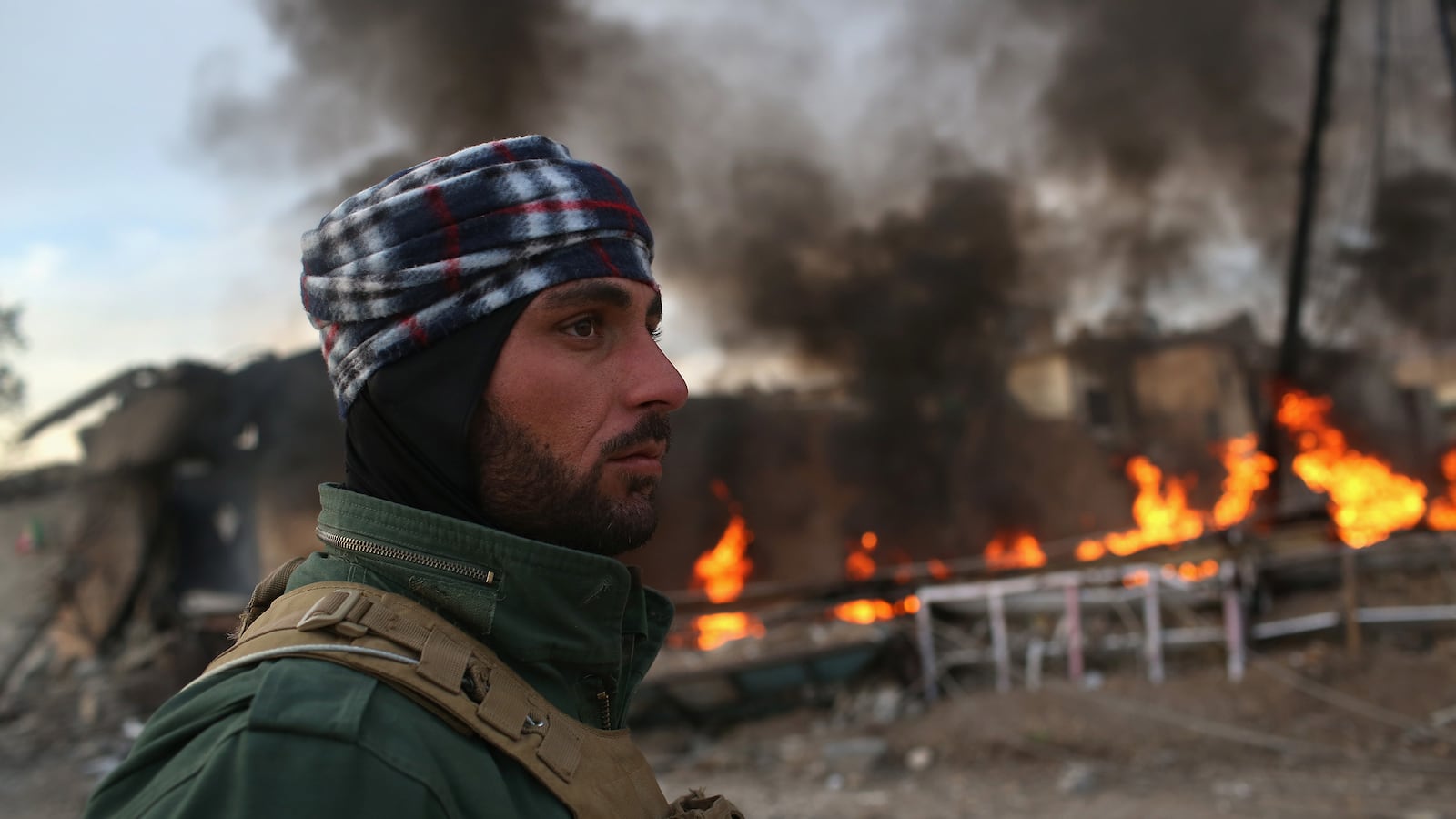SINJAR, Iraq—The bombed-out military base atop Mount Sinjar offered a clear if distant view of the battle unfolding on the plains below. Smoke was rising there. Shia militias were attacking fighters from the so-called Islamic State in villages that ISIS swept into almost three years ago, beginning an orgy of violence that still haunts the survivors.
The Shia militia on the Sinjar plains are the latest armed group to force its way into this remote region in northwest Iraq that has become the most contested area in the country. Strategically situated near the border with Syria, this heartland of the Iraq’s Yazidi minority is coveted by powerful factions backed by competing regional powers, including Turkey and Iran. And with ISIS on the verge of defeat, tensions are threatening to boil over into open conflict among several erstwhile allies among the forces that are actually on the ground.
The scene here on the mountain records the violent history of the recent past. In the early hours of April 25, Ankara’s warplanes bombed military bases of the Kurdistan Workers Party (PKK), which has waged a decades-long guerrilla war against the Turkish government. The Turkish airstrike brought that metastasizing war into this corner of Iraq.
You could see that one bomb had slammed into the ground next to a telecoms tower on the mountain top, sending oil drums and twisted metal flying. Uniforms were strewn amid the rubble. The guerillas had melted into the shrubland that covers the hillsides, but their flags still fluttered defiantly in the breeze.
Just a couple of hundred meters further along the plateau, however, there were different Kurdish flags. A base of the Peshmerga, as the Kurdish fighters of Iraq are known, was draped in the yellow pennants of the Kurdistan Democratic Party (KDP), which dominates the autonomous region of northern Iraq.
The PKK and the KDP have rarely been on good terms, as the PKK has tried to use KDP territory elsewhere in Iraq as its strategic depth to fight the government in Turkey, and the KDP has tried to prevent that. Both probably would like to see, eventually, an independent Kurdish state in the Middle East, but their strategies are vastly different and their alliances as well. The PKK says officially that it is fighting for greater autonomy and “democratic confederalism,” that is, grassroots democracy. In any case, the two Kurdish groups have been at loggerheads in Sinjar ever since the ISIS onslaught of 2014.
As the regional war has evolved over the last three years, Tehran has developed an interest in using the PKK and the Shia militias of Iraq, known as the Hashed al Shaabi, to its advantage here. The Islamic Republic is keen to establish a land bridge between Iran and Syria, where Iranian money, weapons, troops, and proxy forces play a vital role propping up the Bashar al Assad regime. According to Kurdish officials, Sinjar is a key part of the emerging route that would allow Iran to reach its Syrian ally by land.
"The PKK has opened the door for many militias to come to Iraq and then go to Syria,” says Naser Pasha Khalaf, a senior official with the KDP in Sinjar.
The Iranian-backed militias are taking the initiative. Already they effectively control a corridor from the Iranian border skirting to the south of KDP controlled territory and west beyond Mosul to Tel Afar, an ISIS stronghold that the Hashed militia are besieging. After taking Tel Kassab and Tel Banat, two villages near Sinjar city, the Shia fighters can now link up with other client forces, completing the Iran-Syria corridor. And they are poised to expand that corridor by taking more land from ISIS as they fight their way toward the Syrian frontier.
Across the border, Kurdish territory in Syria continues the link between Iran and forces connected to Syrian President Assad. The PKK's Syrian political and military subsidiaries have held a truce with the Assad regime since the outbreak of the civil war. Their Kurdish enclave in Syria's northeast abuts regime territory, and is linked to Sinjar just across the border in Iraq.
A complicating factor in all this: the PKK’s Syrian franchise, known as the YPG, is recognized by the United States as the most effective fighting force available to go after the ISIS capital in Raqqa, Syria, even though on the ground beneath Mount Sinjar in Iraqi territory, a stone's throw from the Syrian border, the same force is aiding and abetting the Assad regime's greatest regional ally.
But Iran's momentum in northern Iraq could be checked by Turkey. Ankara regards the PKK as a mortal enemy, and also has been a staunch opponent of Assad since the outbreak of the Syrian civil war in 2011.
Turkish President Recep Tayyib Erdogan has threatened intervention repeatedly because of the Shia militia involvement in the current Mosul offensive and the militias’ push on Tel Afar. After the air strikes on the PKK in Sinjar, speculation about a Turkish ground invasion grew intense.
As the pressure cooker of regional tension heats up, it is the Yazidis who stand to lose the most from the tug-o-war over what are their ancestral lands.
"The tension between the KDP and the PKK is one of the main reasons why Yazidis are not moving back to their homes. They expect a fight, and if they fight there will be a war," says Dakheel Ismail, who belongs to a Yazidi militia operating under the auspices of the KDP.
When ISIS stormed into Sinjar on August 3, 2014, the KDP Peshmerga stationed in the area retreated immediately, leaving the local Yazidi population at the mercy of the terror group. ISIS regards the Yazidis, who practice an ancient religion predating Islam and Christianity, as devil worshippers. As the insurgents swept through the villages surrounding Mount Sinjar, they shot the men, dumping the bodies into mass graves, and trucked off the women and children into slavery.
Thousands of Yazidis were killed or captured, but many more managed to reach the safety of Mount Sinjar, a craggy ridgeline that rises gently from the plains.
The ISIS offensive threatened Erbil, the capital of Iraq’s Kurdish regional government, and also presented the United States with a dramatic humanitarian crisis. In early August 2014, even as President Barack Obama vowed that “as commander in chief, I will not allow the United States to be dragged into another war in Iraq,” his airstrikes against ISIS and his airdrops to the Yazidis on Mount Sinjar started just that process.
On the ground, meanwhile, it was in fact the PKK's Syrian spinoff, the YPG, that proved the most effective fighting force, breaking through the ISIS siege of Mount Sinjar and establishing a safe route evacuating Yazidis to Kurdish-controlled areas of Syria.
By the time ISIS was pushed back from the northern half of the Sinjar region in September that year, the PKK had established a firm foothold in the area, and the group did not relinquish it even after helping to expel the jihadists from Sinjar city in November 2015.
With the common enemy pushed out of the town that is nestled on the south side of the mountain, the two Kurdish factions, the PKK and KDP, increasingly took umbrage at each other’s presence.
"After the liberation of Sinjar the relationship got worse by the day," says Deshwar Fakher, a commander of the Yazidi militia recruited and trained by the PKK shortly after the 2014 fall of Sinjar. It has recruited among Yazidis who had lost faith in the Peshmerga, and who reject KDP hegemony over the area. At the same time, some prominent local leaders did throw their lot in with the KDP, bringing thousands of Yazidi fighters into the Peshmerga fold.
"The PKK wants to control Sinjar, and the KDP wants to control Sinjar. If they fight each other, the victims will be the Yazidis, because Yazidis have joined both parties," says Khalaf Haji Khalaf. Khalaf, a beekeeper and former liquor store owner, is one of the few inhabitants of Sinjar city to return to the heavily destroyed town.
Tensions spilled over into violence on March 3, when a firefight broke out between the PKK- allied militia and KDP Peshmerga in the village of Khanasor, reportedly resulting in casualties on both sides. In Sinjar city and on the mountain, the two parties cast wary glances at each other across the rubble, but refrained from hostilities while ISIS still controlled the countryside only a few kilometers to the south.
Still, the Iraqi Kurds’ regional government dithered over liberating the flatland of south Sinjar, much to the chagrin of Yazidis fighting alongside the Peshmerga who think it’s time to go home.
"We want to, but the Kurdish politicians won't let us,” said Ayub Murad, whose unit of local Yazidi fighters holds part of the front line straddling the south of the mountain. “They told us they are waiting for permission from the U.S. army."
Hundreds of thousands of Yazidis have yet to return to their homes, and most of the displaced languish in refugee camps in the Kurdish region. The ISIS blitz in 2014, and the heavy coalition air support for operations to push the jihadists back, has left many houses destroyed, and reduced much of the infrastructure to rubble. Basic services like water and electricity are missing. The continued presence of the insurgents in the area has dissuaded many traumatised Yazidis from returning.
"Our house was destroyed and Sinjar is still not secure. We want to move back but it is not safe to do so yet," says Barakat Thabo, who works at a medical station in Sinjar, but whose family lives in the Khanke camp near the Kurdish city of Dohuk.
The competing Kurdish factions blame each other for the continued absence of the local population.
The PKK-allied Yazidis (their acronym: YBS) accuse the KDP of deliberately undermining returnees in order to maintain control over the area.
"If the Yazidis returned from the camps, the YBS would grow and become more powerful than the Peshmerga," says Deshwar Fakher, the YBS commander.
Yazda, a charity fighting for Yazidi rights, last year claimed that the Iraqi Kurdish regional government was blocking construction equipment, medical supplies and even foodstuffs from entering the area in a possible attempt to discourage displaced people from returning. Trucks with building equipment and medical supplies can be seen passing the KRG checkpoint on the road into the Sinjar, however.
Sources within the KDP meanwhile accused the PKK of forcibly recruiting and brainwashing underage Yazidi boys and girls. The guerilla presence creates a security threat by attracting unwanted attention by Turkey, they add.
"Because of the PKK we have the Turkish airstrikes," says the KDP's Khalaf.
Used to living a secluded life in an obscure part of Iraq, the battered Yazidi community is fed up with this battle over its territory. While many of them have taken sides in the polarizing conflict, most say they prefer for Sinjar to become an autonomous region within Iraq.
On the grassy plateau of Mount Sinjar, a cluster of tents lines the road traversing the mountain. Several thousand Yazidis remained here after seeking refuge from ISIS in 2014, and one of them is Qasim Shewan, who led a group of Yazidis who took part in the desperate defense of the mountain.
A revered figure in the Yazidi community, Shewan has spurned the advances of the various factions vying for control of Sinjar. His independence allows him to speak freely, and he does not mince his words.
"Different parties are trying to gain influence in Sinjar, and the Yazidis are victims of this. The solution is for no Kurdish parties to be in Sinjar. We don't trust any party any more," he says.






